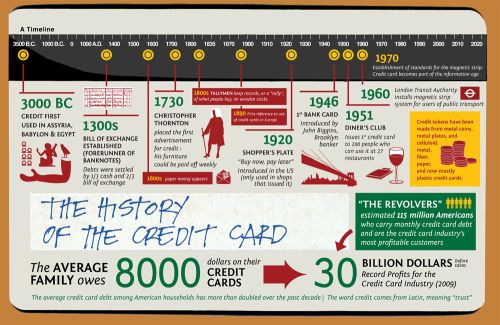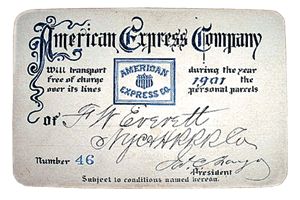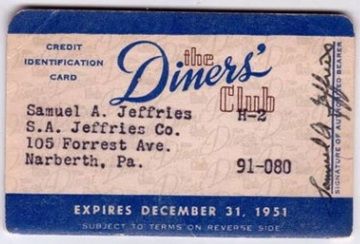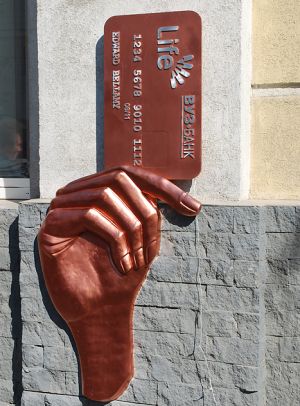The history of the origin of the credit card begins at the end of the first half of the 20th century. It's amazing that the credit card, like many great inventions, was invented by accident.

According to legend, a New York businessman named Frank McNamara (head of the financial company Hamilton Credit Corporation) in 1949 dined with a company of his friends in a New York restaurant. Sitting at a table, they talked about the difficult financial situation of one of the company's clients, Frank McNamara. This man was the owner of several credit books of the shops in which he had a loan. It so happened that several of his friends asked him for a loan. He did not give money to his friends, but allowed them to use his credit books for a certain percentage, which his friends had to pay him along with the main debt. As a result, credit on books has grown significantly, and debtors, for various reasons, could not pay their debt.
The beginning of the credit card history
After dinner, Frank decided to get out his wallet, but to his regret, he found that he had forgotten it at home. He had to call his wife and ask her to bring the urgently needed amount. Further deliberation of this ridiculous situation and the case with his client led to the emergence of a new idea - a universal credit card, with the possibility of using it not by one particular store, but by many commercial institutions. This idea formed the basis of the history of credit cards as we see them today.

The first credit paper card (check)
"American Express" 1901-year issue.
At the beginning of the 20th century, credit books and credit cards issued by commercial institutions were very popular. This allowed the companies to ensure the loyalty of their customers - the debtor would return to the store anyway, and, with a high degree of probability, would want to buy something else. Credit cards were usually issued to regular paying customers. For a large list of purchases on credit, a large number of credit cards had to be used, a separate card for each store. For example, in 1891, American Express, known as a reliable courier service that transported money between individuals, companies and banks, issued the first American Express Traveler's Check.
The genius of Frank McNamara's idea was that he came up with only one single universal credit card for all retail outlets. And by this time, cars began to spread and air travel became more affordable - people began to travel, and the idea of a universal credit card came in handy. The novelty of the universal credit card concept was the use of an intermediary company between the selling companies and the buying customers.
Diners Club card issuance
McNamara discussed his idea with partners (Alfred Bloomingdale, grandson of the founder of the famous Bloomingdales store and lawyer Ralph Snyder), and in 1950 the Diners Club company was born with a start-up capital of $ 75,000, the opening of which is considered the beginning of the founding of the modern credit card. The company was to act as an intermediary between customers and sellers. Now, not every company offered its own loan individually, and Diners Club, being an intermediary, made it possible to open a loan to the clients of many companies. The same Diners Club undertook to collect money from debtors, holders of its credit cards, which would greatly facilitate the life of other companies, since the problem of non-repayment of loans and, simply, fraud, was very acute. Diners Club planned to earn money by paying for intermediary services. The tariffs were set as follows: Companies will pay 7% on every purchase made with a Diners Club credit card, and cardholders will pay an annual fee of $ 3.
It was assumed that the first customers of Diners Club would be businessmen - frequent visitors to restaurants who were wealthy people and showed interest in the new service. As a result, about two hundred people became the owners of the first Diners Club credit cards, mostly they were friends and acquaintances of the company's owners. Actually, this explains the name of the company Diners Club, which, in translation into, can be read as "Lunch Club" or "Club of Restaurant Regulars".

The first Diners Club credit card.
The cards were initially accepted in several dozen New York restaurants. They were printed on a rectangular piece of thick paper. On the back of the card was a list of all the restaurants where you could eat on credit. Regular restaurant customers, owners of the Diners Club card, presented it in many restaurant establishments in New York instead of cash. The restaurants then sent copies of the invoices to the Diners Club, which issued a monthly invoice to the client. As a result, the client paid with Diners Club, and that one with restaurants. A similar scheme works in our time.
In the beginning, the company was not doing very well. The restaurant owners were not happy with the interest on the loan and they had concerns about the possible competition of Diners Club cards with their own credit books. Merchants have not seen enough demand for cards either. In turn, potential customers were in no hurry to purchase Diners Club cards until they began to be accepted in many retail establishments.
Another obstacle to universal credit cards has been resistance from various large companies (airlines, oil companies, and other trading firms) issuing their cards. They were reluctant to pay the middleman and were afraid that the new card would weaken their market position and customer relationships.
Despite all these difficulties, already in 1950 about 20 thousand New Yorkers were paying in restaurants with paper slips from the Diners Club. And in the second year of its existence, the company made a profit of 60 thousand dollars, which showed financial success and predetermined the future prospects of the new enterprise.
Diners Club continued to develop out of competition until 1958, when new players appeared on the horizon of the American card business: American Express, Bank of America and other large companies. Subsequently, Diners Club expanded its scope of activities and began to offer its credit services in the entertainment and travel industry.
It is noteworthy that all cards at the very beginning of their existence allowed their holders to receive practically unlimited loans from banks. The reason for this fact was that the presence of a card in a person was automatically identified with his solvency, which was what various fraudsters began to use, who took a lot of money on credit, and then hid with them in an unknown direction.
Gradually, the infrastructure of credit cards developed, with the development of the economy and technology, new solutions appeared, which led to the total spread of this banking product. The convenience of using cards has improved, they have become more secure for carrying out any financial transactions.
In the modern world, almost every resident of prosperous countries has credit cards. Thanks to their advantages, they have presented people with incredible opportunities, compared to earlier schemes of financial and credit relationships, and are gaining more and more popularity around the world every day.
Credit card monument

A credit card monument appeared in Yekaterinburg in 2011 at the intersection of Malysheva Street with Bankovsky Lane. The sculpture itself is made in the shape of a hand holding a credit card.
The idea of such a monument came from the Yekaterinburg "VUZ-Bank" and was timed to coincide with the 20th anniversary of the bank, as stated on the official portal of this credit institution.
The authorship of the sculpture project belongs to the Yekaterinburg sculptor Sergei Belyaev. The size of the composition is approximately 4 square meters. The hand with the card is cast iron and has a bronze finish. The "credit" card itself weighs over 100 kg. As conceived by the bank, the plot of the composition was conceived with the aim of attracting financial wealth.
On the image of the card there is the name of its owner, who chose the famous American utopian writer Edward Bellamy. The choice of the sculptor is explained by the fact that it was Bellamy who, in his dystopian novel A Look into the Past, published in 1888, was the first to predict the emergence of credit cards.
The card also has a date of issue - 08.2011, and a bank account number: 1234 5678 9010 1112.
According to the bank's press secretary, the initiators of the installation of the sculpture hope that their brainchild will take root in Yekaterinburg, and legends and beliefs may arise around the monument. For example: if you rub a card, it means money.
The sculpture installed in Yekaterinburg is the only one in the world installed in honor of a payment instrument - a bank credit card.
(c) privatbankrf.ru

According to legend, a New York businessman named Frank McNamara (head of the financial company Hamilton Credit Corporation) in 1949 dined with a company of his friends in a New York restaurant. Sitting at a table, they talked about the difficult financial situation of one of the company's clients, Frank McNamara. This man was the owner of several credit books of the shops in which he had a loan. It so happened that several of his friends asked him for a loan. He did not give money to his friends, but allowed them to use his credit books for a certain percentage, which his friends had to pay him along with the main debt. As a result, credit on books has grown significantly, and debtors, for various reasons, could not pay their debt.
The beginning of the credit card history
After dinner, Frank decided to get out his wallet, but to his regret, he found that he had forgotten it at home. He had to call his wife and ask her to bring the urgently needed amount. Further deliberation of this ridiculous situation and the case with his client led to the emergence of a new idea - a universal credit card, with the possibility of using it not by one particular store, but by many commercial institutions. This idea formed the basis of the history of credit cards as we see them today.

The first credit paper card (check)
"American Express" 1901-year issue.
At the beginning of the 20th century, credit books and credit cards issued by commercial institutions were very popular. This allowed the companies to ensure the loyalty of their customers - the debtor would return to the store anyway, and, with a high degree of probability, would want to buy something else. Credit cards were usually issued to regular paying customers. For a large list of purchases on credit, a large number of credit cards had to be used, a separate card for each store. For example, in 1891, American Express, known as a reliable courier service that transported money between individuals, companies and banks, issued the first American Express Traveler's Check.
The genius of Frank McNamara's idea was that he came up with only one single universal credit card for all retail outlets. And by this time, cars began to spread and air travel became more affordable - people began to travel, and the idea of a universal credit card came in handy. The novelty of the universal credit card concept was the use of an intermediary company between the selling companies and the buying customers.
Diners Club card issuance
McNamara discussed his idea with partners (Alfred Bloomingdale, grandson of the founder of the famous Bloomingdales store and lawyer Ralph Snyder), and in 1950 the Diners Club company was born with a start-up capital of $ 75,000, the opening of which is considered the beginning of the founding of the modern credit card. The company was to act as an intermediary between customers and sellers. Now, not every company offered its own loan individually, and Diners Club, being an intermediary, made it possible to open a loan to the clients of many companies. The same Diners Club undertook to collect money from debtors, holders of its credit cards, which would greatly facilitate the life of other companies, since the problem of non-repayment of loans and, simply, fraud, was very acute. Diners Club planned to earn money by paying for intermediary services. The tariffs were set as follows: Companies will pay 7% on every purchase made with a Diners Club credit card, and cardholders will pay an annual fee of $ 3.
It was assumed that the first customers of Diners Club would be businessmen - frequent visitors to restaurants who were wealthy people and showed interest in the new service. As a result, about two hundred people became the owners of the first Diners Club credit cards, mostly they were friends and acquaintances of the company's owners. Actually, this explains the name of the company Diners Club, which, in translation into, can be read as "Lunch Club" or "Club of Restaurant Regulars".

The first Diners Club credit card.
The cards were initially accepted in several dozen New York restaurants. They were printed on a rectangular piece of thick paper. On the back of the card was a list of all the restaurants where you could eat on credit. Regular restaurant customers, owners of the Diners Club card, presented it in many restaurant establishments in New York instead of cash. The restaurants then sent copies of the invoices to the Diners Club, which issued a monthly invoice to the client. As a result, the client paid with Diners Club, and that one with restaurants. A similar scheme works in our time.
In the beginning, the company was not doing very well. The restaurant owners were not happy with the interest on the loan and they had concerns about the possible competition of Diners Club cards with their own credit books. Merchants have not seen enough demand for cards either. In turn, potential customers were in no hurry to purchase Diners Club cards until they began to be accepted in many retail establishments.
Another obstacle to universal credit cards has been resistance from various large companies (airlines, oil companies, and other trading firms) issuing their cards. They were reluctant to pay the middleman and were afraid that the new card would weaken their market position and customer relationships.
Despite all these difficulties, already in 1950 about 20 thousand New Yorkers were paying in restaurants with paper slips from the Diners Club. And in the second year of its existence, the company made a profit of 60 thousand dollars, which showed financial success and predetermined the future prospects of the new enterprise.
Diners Club continued to develop out of competition until 1958, when new players appeared on the horizon of the American card business: American Express, Bank of America and other large companies. Subsequently, Diners Club expanded its scope of activities and began to offer its credit services in the entertainment and travel industry.
It is noteworthy that all cards at the very beginning of their existence allowed their holders to receive practically unlimited loans from banks. The reason for this fact was that the presence of a card in a person was automatically identified with his solvency, which was what various fraudsters began to use, who took a lot of money on credit, and then hid with them in an unknown direction.
Gradually, the infrastructure of credit cards developed, with the development of the economy and technology, new solutions appeared, which led to the total spread of this banking product. The convenience of using cards has improved, they have become more secure for carrying out any financial transactions.
In the modern world, almost every resident of prosperous countries has credit cards. Thanks to their advantages, they have presented people with incredible opportunities, compared to earlier schemes of financial and credit relationships, and are gaining more and more popularity around the world every day.
Credit card monument

A credit card monument appeared in Yekaterinburg in 2011 at the intersection of Malysheva Street with Bankovsky Lane. The sculpture itself is made in the shape of a hand holding a credit card.
The idea of such a monument came from the Yekaterinburg "VUZ-Bank" and was timed to coincide with the 20th anniversary of the bank, as stated on the official portal of this credit institution.
The authorship of the sculpture project belongs to the Yekaterinburg sculptor Sergei Belyaev. The size of the composition is approximately 4 square meters. The hand with the card is cast iron and has a bronze finish. The "credit" card itself weighs over 100 kg. As conceived by the bank, the plot of the composition was conceived with the aim of attracting financial wealth.
On the image of the card there is the name of its owner, who chose the famous American utopian writer Edward Bellamy. The choice of the sculptor is explained by the fact that it was Bellamy who, in his dystopian novel A Look into the Past, published in 1888, was the first to predict the emergence of credit cards.
The card also has a date of issue - 08.2011, and a bank account number: 1234 5678 9010 1112.
According to the bank's press secretary, the initiators of the installation of the sculpture hope that their brainchild will take root in Yekaterinburg, and legends and beliefs may arise around the monument. For example: if you rub a card, it means money.
The sculpture installed in Yekaterinburg is the only one in the world installed in honor of a payment instrument - a bank credit card.
(c) privatbankrf.ru
